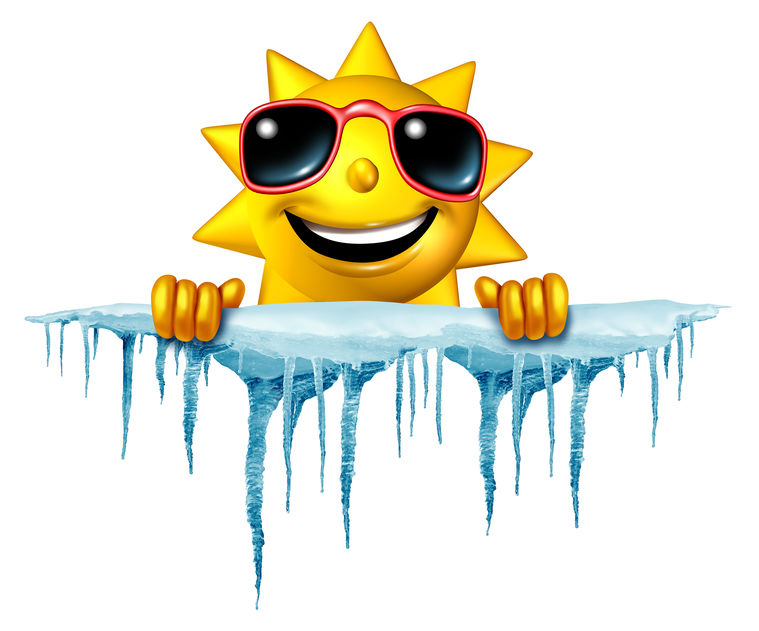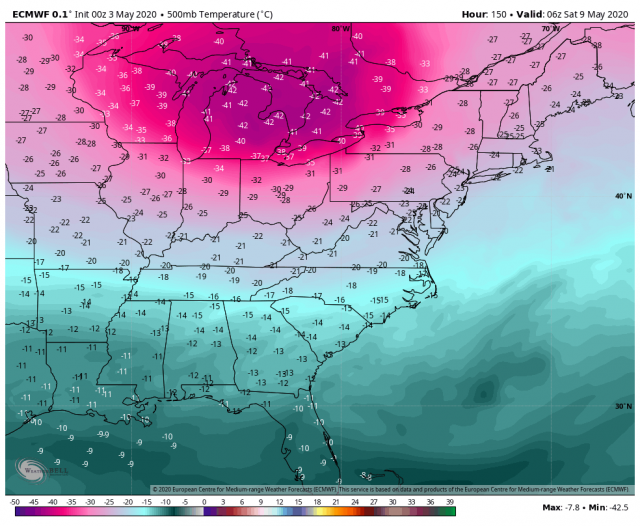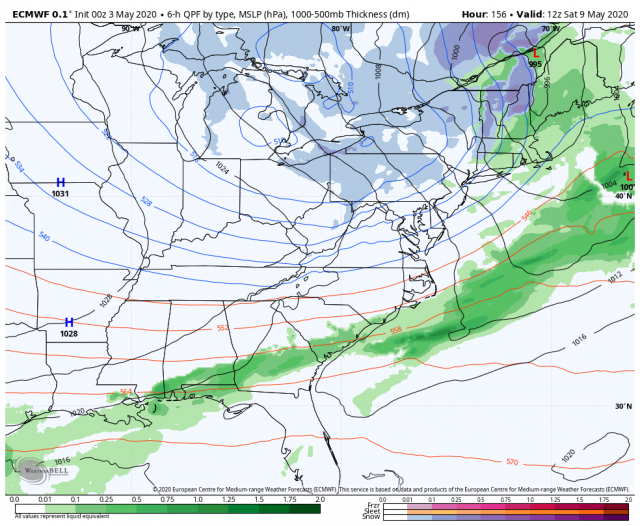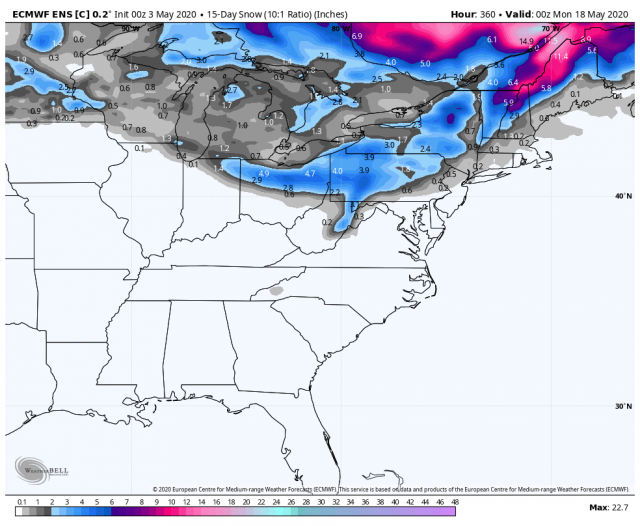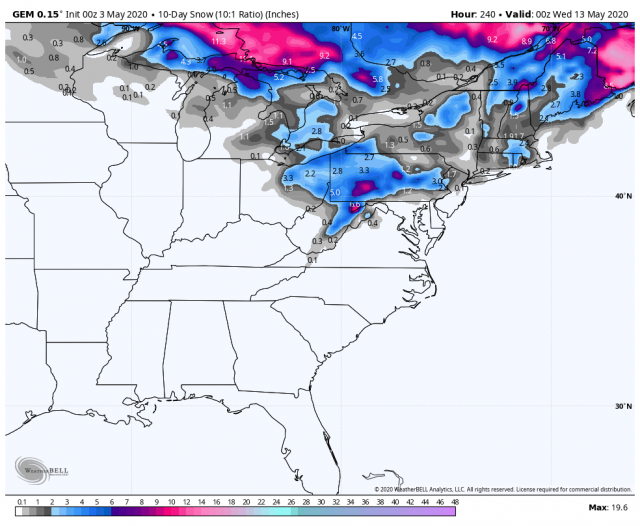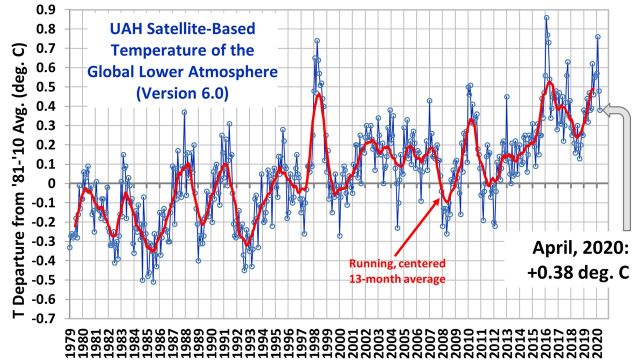Back in April. much was made of the record heat in Florida and rightfully so. All-time records should be brought to the attention of the public.
The hypocrisy of Attribution was obvious because while the short period snapshot of Florida heat was noteworthy, it totally ignored what was going on for the rest of the nation. To include a top 10 coldest April since 1981, which was the coldest 500mb temperature ever recorded over the US in April, at -43. I have never seen a temp that cold in April ( -40 in winter is a gold standard of cold). Well here it comes again. The European model has a forecasted temperature of -42 over Michigan May 9.
It has the lowest 1000-500 mb that I have ever seen this late with a 510 core over Michigan
The Canadian is not far behind.
While I believe a lot of people will see snow in the air at the lakes, midwest and northeast, I am not yet buying into a snowstorm idea like this. I think it is possible, but as of yet, not probable.
What’s wild, is that we have such a chance on the playing field this time of the year. We did get an outbreak in 1976 that resulted in snow on May 19th which reached central PA. To add, it did snow on Snowshoe mountain during Agnes but that is quite elevated. At that time the lowest 1000-500 mb with that was around 525 with the May 19th outbreak, not 510. Over Snowshoe it was well into 540, of course, that was also in June which makes it impressive. One may say, “Well, what about Sandy in WV in 2012”? The difference is sun angle. October has a much lower sun angle, and much less time of sun than May or June.
If this kind of cold happens, it will be the counterweight, twice, to what happened in FL. However, there is a counterbalance to this like the heat in the west, which will be mid-summer. When we look for major heat in the west we will find major cold in the east. But the question is, will this cold gather as much attention as the FL heat, or the western heat?
I do not believe this is the sign of the little ice age returning, It is tempting if one is into an eye for an eye mentality, to say, see this as a sign, And we do see that. In fact, there is much being made of the 2nd greatest 2 month drop off ever in the satellite temps.
However, it’s still a top 10 warmest April on record. On the NCEP CFSR it’s second warmest. Since the Super Niño, we have had the longest-running stretch of above-average temps on record. What is lost in trying to push this as some kind of evidence of “global cooling” is that it’s relative to the warmth that we are in.
But the counterweight to that is the distortion of the warming which shows up greatest in the coldest, driest areas. My hypothesis, which I agree is open for debate, but is a point that should enlist debate, is this points the finger at the oceans and outsourcing of WV from their naturally warmed states. This as water vapor has far greater effects on where it’s cold and dry. But all of you that have read my thoughts know, I am putting this forth as an idea, not that I am right, everyone else is wrong, end of the story. That is a far cry from the stance taken on the other side with the warming issue.Additionally, not only will the heat be stressed where it occurs, but the extreme will be stressed, saying “see, things are getting more extreme”.
This to me shows a lack of respect for what nature is capable of. I’ll give an example: Something I am digging into is underwater hydrothermal vents and their effects. It is very difficult to find these because no matter how many deep-diving instruments you have, the ocean is so expansive its hard to find them. One such family of them for instance just showed up off Washington coast.
But even one area going off can enlist reactions in other areas, some quickly some not. So if you have a vent that warms a part of the ocean, there may be compensating cooling nearby. But then the feedback from that likely causes another effect someplace else. Since the warm water has shown up strongly east of New Zealand for instance, the water has become very warm in the gulf and the western Atlantic, That is not because of a warm vent in the southern hemisphere warming the water in the gulf, but follow this. A large part of that is the natural cycle of the Atlantic. That warm water source, where it is, may disperse in a way that changes the Pacific to such where the MJO may have a reaction to it. That, in turn, favors patterns to change elsewhere.
We know that phase 4-6 of the MJO are US warm phases in winter. If you get that, then there are no major intrusions of cold air into the southeast, and the Gulf and western Atlantic refuse to cool as much as average. They start warmer going into the summer season and stay warm. How can nature take that warm water out of there? Hurricanes are one way as they cause immense upwelling of cold water. So one thing far away may have one its sources something a half a world away. As I have grown more cross-equatorial in my diagnostic methods, I have notice similarities to Australia and the US in temperature patterns for instance. My point is here, there is a vast source of information we do not have in relation to cause. So I am putting out some ideas here, which are debatable.
However, there is a problem that may be foretelling of a sudden snap to cooler in the coming decades. You see the increase in WV would be un-noticed in precip patterns if the upper levels were warming proportionally so that condensation process remains the same. Instead, there are distinct increases in precipitation showing up. The US, while a very small area, makes a very good example, for it is positioned at a crossroads for air masses.
The US is closer to the equator than the pole, so the warming around it naturally will encourage warmth. But this is largely in the lower levels of the troposphere. The upper levels are not warming as fast and over the tropics, actually drying a bit. This is like pulling a rubber band, eventually, it is going to snap (note that analogy was one From Dr Joel Myers, founder of Accuweather. I always try to acknowledge my sources)
So we have a whole set of events going on and the crucial question in the longer term for climate has to do with attribution. Right now in most of the man-made climate change communities, CO2 is the big kahuna, but if so, then why would one want it back to levels when global temperatures were that cold? Given the increase in population and food production, you would be inviting increases in hunger. Look what a ruckus this cold is making this spring.
To compound supply chain problems for a food supply caused by the virus, now there is a threat inherent in very late spring that an early-season cold shot can cause crops that started late not to have reached maturity. That is a concern given the MJO which is now running thru its cold phases and looks like it may do it all summer into fall (also a marker for a high impact hurricane season, as cool air over the US and higher than normal pressures, given the in close SST invites stronger convergence within a few hundred miles of our coastlines.
While the Harvey and Michaels, storms that deepen till they hit, have been the exception in the warm era as hurricanes have been stronger over the water rather than landfall on the US coast. Classic examples: Irene, Matthew, Florence, Dorian all weakened as they came at the US. In the 30s-50s, storms hit at full stride more often. This year it would be surprising to me if the exceptions did not show up. But the groundwork for all these events may in part be laid in other areas and over longer periods of time. Over attribution, to once source means the entire Meteorological/Climatological community could miss the true problem, which is a sudden flip if one or more of the big drivers of the oceans come apart. Again I am simply offering that idea.
If there is a silver lining to the Covid-19 cloud, it may be that if we don’t see any reaction at all in the rate of CO2 increase vs the previous year, then that means some questions arise. I am starting to read the “explanations” though many seem dated.
One such is that there was only a 5% decrease in actual global economic activity. Yet it threw the world into a depression and somehow that was a good thing for man’s advancement? Or that there was some decrease in the rate of increase, but we see that every year when Sea ice reaches its maximum extent, that the rate flattens ( I got this idea from Tom Downs). Once the sea ice starts to melt, it resumes its upward rise, like it did last year, the year before, etc etc, It appears to be hitting a record high just before the turn around due to the greening of the northern hemisphere takes over. Which by the way, being objective, would mean that less sea ice means more CO2. But is it natural warming that is the cause of that? So at the least this should mean the climate community should start looking at such things, IMO.
But this late cold is no surprise overall. What was a bust is when it came, I thought it would start earlier and so no late winter rally to get us to what I forecasted. But its showing some of the points we had about the cold season itself. Just like Florida lived through history with its hottest April temperatures on record in some places, there is the usual counterweight showing up. The lesson is not that either is a sign of man-made climate change, but that in the majesty of nature. Few really can understand the limits weather can go to. Oh, we think we do, but the fact is when it comes to weather and climate, simply because of the lack of information in our oceans. the cause for instance of increased underwater volcanic activity, some link it to solar, the biggest problem I see, there is much more we don’t know than we do know.(Know and believe are 2 different things) But while there are many that will curse the cold, curse the warmth, curse a hurricane, point a finger at a cause, I guess I am in the camp of sitting back in awe and wonder of all I see relative to how little I really know.
